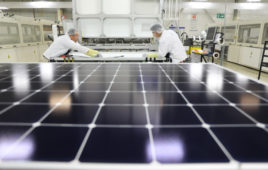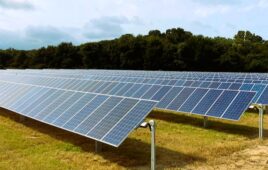Metal-hydrogen battery company EnerVenue announced today it has raised $100 million in Series A funding that it will use to build a gigawatt-scale factory in the United States, accelerate R&D efforts and expand its salesforce.
 Schlumberger New Energy led the round, accompanied by Saudi Aramco Energy Ventures and others including Stanford University. EnerVenue has also announced a major distribution and manufacturing agreement with Schlumberger to expand global availability of EnerVenue batteries, namely in Europe, the Middle East and Africa.
Schlumberger New Energy led the round, accompanied by Saudi Aramco Energy Ventures and others including Stanford University. EnerVenue has also announced a major distribution and manufacturing agreement with Schlumberger to expand global availability of EnerVenue batteries, namely in Europe, the Middle East and Africa.
EnerVenue’s batteries use nickel-hydrogen technology that has been tested for decades on the International Space Station and Hubble Space Telescope. The company formed in 2020 to bring the NASA-originated technology to grid-scale and other stationary power applications.
 “With the durability, flexibility, reliability, and safety of its batteries, EnerVenue is delivering a unique and future-proof solution for grid-scale energy storage,” said Jorg Heinemann, CEO, EnerVenue. “We have proven the advantages that our next-generation nickel-hydrogen battery delivers and are excited to accelerate our journey forward with Series A backing and our agreement with Schlumberger.”
“With the durability, flexibility, reliability, and safety of its batteries, EnerVenue is delivering a unique and future-proof solution for grid-scale energy storage,” said Jorg Heinemann, CEO, EnerVenue. “We have proven the advantages that our next-generation nickel-hydrogen battery delivers and are excited to accelerate our journey forward with Series A backing and our agreement with Schlumberger.”
EnerVenue nickel-hydrogen batteries can work in -40° to 60°C (140°F) temperatures with projected 30,000-cycle lifespans. With no lithium, the batteries have no thermal runaway risk. Also with no toxic materials and easily separable parts, the batteries are expected to be 100% recyclable.




“EnerVenue nickel-hydrogen batteries can work in -40° to 60°C (140°F) temperatures with projected 30,000-cycle lifespans. With no lithium, the batteries have no thermal runaway risk. Also with no toxic materials and easily separable parts, the batteries are expected to be 100% recyclable.”
There is no free lunch, this is around 1.55VDC cell voltage and is therefore about as gravimetrically energy dense as lead/acid battery storage packs used for decades in past energy storage projects. The ‘thing’ found out about Nickle-hydride energy storage discovered when billions of dollars were spent on R&D of hydrogen fuel cells in the late 1980’s and early 1990’s was the Nickle matrix starts out porous and then as it is cycled, the Nickle begins to (powder) and compact losing surface area until the battery is at only 50% efficient in energy storage as when the cell was new. Has EnerVenue corrected this problem? Also using Nickel as a storage medium for hydrogen, it was necessary to heat the cell to release the hydrogen, so the round trip energy loss was greater than lithium ion or even old lead/acid chemistries. Interesting on the EnerVenue web site, the claims that this technology is stable for 30 plus years is interesting and plus or minus 5/C charge/discharge capability. In chemistry terms the most “electronegative” energy pairing is hydrogen and fluorine, something you certainly want to (contain), but would be able to create a cell with around 7VDC per cell. Basically perhaps NiF2 could be used if the cell structure is dendrite immune.